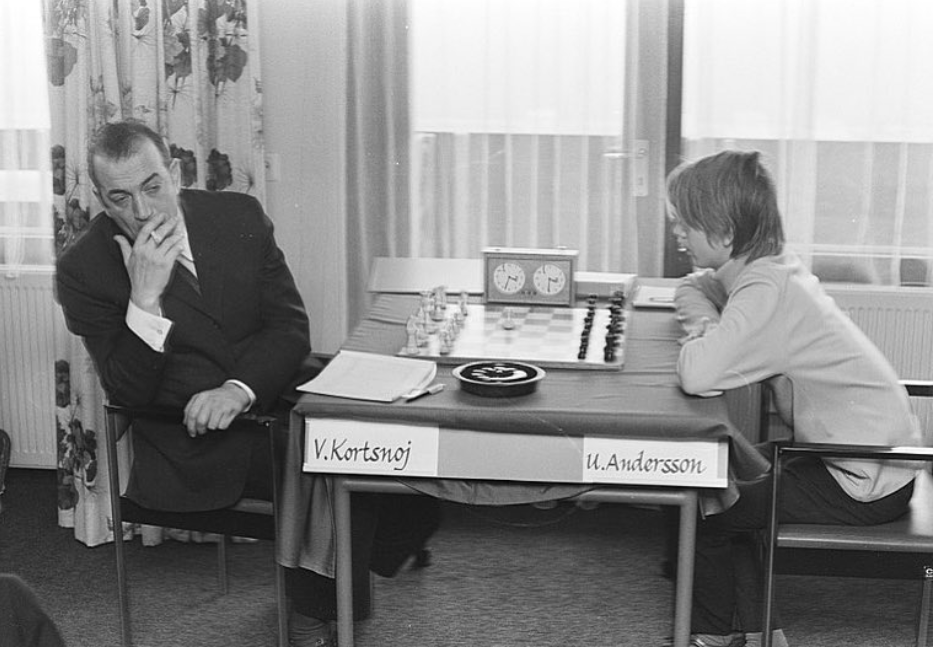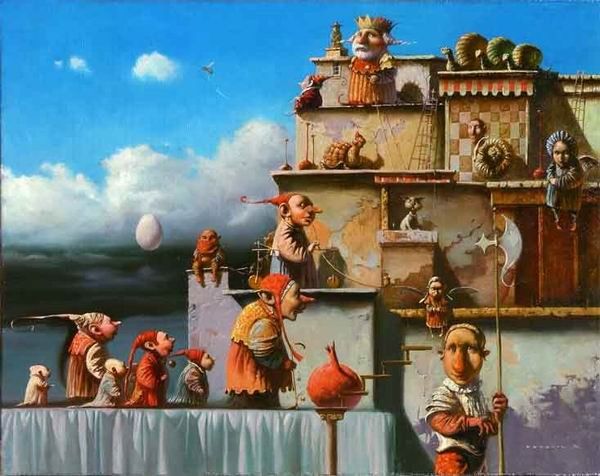
(W)Ulf is at Korchnoi's Door!
Look closely at this anthological chess photo. An all-time.
Wijk aan Zee, Jan 13, 1971. The second round of the Hoogovens.
The World's #3 and later winner of the event is facing the 19-yo Ulf Andersson of Sweden. Viktor the Terrible plays 1.d4, presses the clock after a four-minute deliberation and, turned aside, somewhat nonchalantly is puffing his cigarette. Is he playing some psychological tricks on the young and inexperienced Uffe? He, himself, sort of mesmerized, is watching with awe his formidable, case-hardened, twenty years older opponent.
Ulf makes his move and the game continues on. The game adjourns. #3 tells the journalists that he stands slightly better. Ulf reckons differently.
The game resumes. Korchnoi finally realizes that Blacks actually stand very good. He offers a draw. Ulf declines and the previously quiet playing hall becomes agitated with journalists and other players round his table. What is happening? The boy is blatantly turning #3's draw offer down?!
Korchnoi begins to think his moves for longer times. The game adjourns for the second time. The game resumes for the second time.
73...a3.
The chess sensation from Sweden collects his very first win over a Grandmaster. The skalp of the world's #3 at that.
.
.

The young Ulf during the game
Here is this game's loser, the later victor of the tournament, Viktor Lvovich
"Before me sat a boy, with legs somehow unprofessionally tucked underneath him. I was unable to concentrate and play seriously. Then I saw that I stood worse, and offered a draw. The boy was embarrassed, and blushed, but found the strength of mind to decline the offer. I began playing for all I was worth, but it was too late. The young Andersson, after his usual time trouble, avoided all the hidden traps, and won." - Korchnoi, 'Chess is My Life - Autobiography and Games'

Below is the game with a commentary by Jan Berglund in Swedish, as published in the Tidsskrift för Schack Swedish chess magazine.



TEST YOURSELF - PLAY LIKE ULF
Here is a position from the game Ulf played van den Berg at the same event. After Black had done his pretty ordinary looking move, van den Berg capitulated. The audience racked their brains. Even the commentators had a moment's difficulty in figuring out what had happened.
.
What is in the head of Ulf?

.
Let us try once again explaining Ulf's extraordinary positional understanding for which he has become a cult figure in some chess circles.
Funny, one can find descriptions of Ulf's style like this, "The Swedish GM Andersson's style is a very dry and boring, so dry and boring that he is considered to be just the brightest star of dry and boring chess of all time, a super-classic of the genre."
And then something like this from the Spanish newspaper Informaciones describing his style of play, when giving a cursory sketch of the tournament participants at Linares 1983:
“[Ulf's game] has the charm of a dormant mollusk that awakens and opens the flaps when the endgame perspective begins to emerge on the board.”
Here is GM Keith Arkell's view on Ulf's style. In his Keith Arkell Celebrates a Sage of Strategy article, first published in the Kingpin 15 (Summer 1989), the British GM explains the usual path of great strategic players. When younger, they are "hackers." Ulf Andersson was not an exception. In the early years he "used to play King’s Gambit and the like, throwing in the kitchen sink in wild attacking games" (P. Griffiths).
Arkell sees a definite pattern in chess: the weaker the player, the more "exciting" the game. There is tactics abound as both players are "unable to control" the game. Over time some of players remain hackers inclined to enjoy gambling, like say Tal, or Velimirovic, or Planinc. They provide fantastic entertainment for themselves as well as for the public whose heroes they become. According to Arkell, it is a sort of distortion from correct chess as they impose their nature on the game.
The other group that also have started off as hackers, learn over time to use their tactical skills to control the game and stop their opponents muddying the waters. This allows them to carry out their long-term strategic ends. Thus most variations occur in the strategist’s head and not on the board at all. "For me," says Arkell, "chess has evolved to its highest level when the tussle revolves around whether a player can make anything out of a fractionally better pawn structure, the equality of strengths between the players ensuring that nothing dramatic happens in the meantime."
Ulf had been a hacker in his youth.
"Now as a world-class GM, Andersson has sublimated his talents to a depth of subtlety which the average player simply doesn’t understand! For this reason the type of game Ulf plays is completely ignored by chess writers."
We all enjoy games exploding in fireworks of bright tactical sparks. The problem we have with Ulf, or Petrosian is that we simply don't possess deeper positional understanding to be able to get their ideas (as they remain under the surface) and grasp the meaning behind them.
.
Correspondence chess
In the 90s, Ulf Andersson left the competitive chess and focused on the correspondence chess. Ulf's corr. games are quite often very tactical, which is in stark contrast with his style of play over the board. In 2002, he reached the top of the corr. rating list. Very few players in history have been as successful as Andersson at both classic and correspondence chess.
The annotations in the following game are from ICCHF GM Sergey Grodzensky on the Russian 'Science and Life' site (nkj dot ru)
.
.
One would think that in the correspondence even the most powerful computer would hardly resist to Ulf! In fact, the only advantage the metal has over humans is speed (and not making one single blunder, while people commit sins and make mistakes; to err is human, to forgive divine and engines). And that is exactly what Ulf points out in an interview when asked about his playing correspondence where he tries new openings, seeking to obtain positions that require a very deep and accurate analysis, which is simply impossible to do in the tournament OTB play due to the time controls. “It is very difficult to find such precise moves at the board,” he says.
* * *
Back to our actors. "Korchnoi had a somewhat strange character. After a tournament in 1957 he appeared at the railway station to see off a player, the only one he lost to at the tournament, just to let him know that he would certainly take revenge next time!" (Sv. Gligoric, I Play Against Pieces, Moscow, 1983, p. 153).
Curious to see how the next encounter between Korchnoi and Andersson turned out to be? And how the revenge worked out?
Stay tuned![]()

